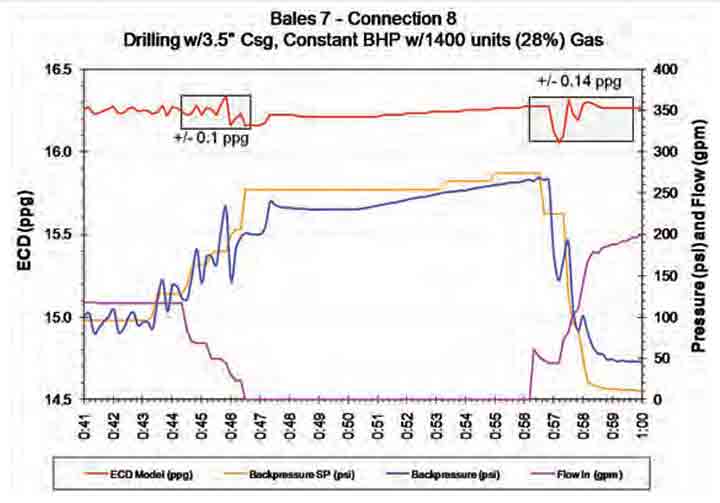A remotely operated clamping system for improved safety in wellbore fluids containment applications.
Operator Eliminates Losses while Drilling with Casing and Cementing in Depleted Onshore Field
Published: 01/07/2013

Operator Eliminates Losses while Drilling with Casing and Cementing in Depleted Onshore Field
Published: 01/07/2013

Eliminating lost circulation, reducing trouble time and cost
Challenged by the unpredictable level of depletion in the gas reservoirs of their McAllen-Pharr field in South Texas, Shell elected to drill with liner and casing and the DAPC dynamic annular pressure control system to reduce ECD and the trouble-time and well cost associated with lost circulation and gas kicks.
These complementary technologies were used to drill six wells through intervals depleted by as much as 5000 psi, with statically underbalanced mud systems when required, and with levels of drill gas that reached as high as 25% by volume.
A modular, small footprint DAPC system was used in one well to drill-in 740 feet of 7⅝-in liner in an 8½-in hole with 15.0 ppg mud statically underbalanced relative to wellbore stability. In another, it was used to drill-in 700 feet of 3½-in tubing in a 6½-in hole with a static mud weight of 15.7 ppg and a dynamic ECD of 16.2 ppg. In that interval the upper limit was estimated to be a 16.5 ppg fracture gradient and the lower limit, a 15.8 ppg pore pressure. This represented the narrowest window drilled to date with casing drilling and the DAPC system.

After reaching TD with the production tubing, the DAPC system was used to manage constant BHP while cementing the production tubing with a 16 ppg slurry. No losses occurred during cementing.
Avoiding losses in severely depleted formations
In the Bales 7 well, the plan was to drill a 6½-in hole below the 7⅝-in shoe in two sections, the upper with jointed pipe down to 10,360-ft MD and the lower with 3½-in production casing to TD, and avoid losses in both.

The challenge in the upper section was to drill out with 13.5 ppg mud and avoid losses in the depleted interval below the shoe where the pore pressure could be as low as 4 ppg and the over-balance as high as 4150 psi. If losses occurred the plan was to drill the section with 5½-in liner. Below this interval, the pore pressure increased to almost 15 ppg, which meant that a large part would be drilled statically underbalanced.
Shell accomplished its objective in the upper 6½-in hole section with MPD which allowed them to avoid the high cost of the 5½-in liner drilling operations.
The challenge in the lower section was high pore pressure, which was expected to increase by as much as 1.5 ppg above the maximum in the upper section. The objective was to minimize the ECD as much as possible and avoid high swab and surge pressure changes. Drilling with 3½-in casing eliminated trip related swab and surge and using MPD allowed Shell to drill with a static mud weight of 15.7 ppg and a constant ECD of 16.2 ppg. Drilling was complicated by high levels of gas that steadily increased throughout, rising as high as 1550 units towards the end of the section.
Shell accomplished its objective in the 6½-in production. They avoided losses and maintained a constant ECD even with high levels of gas.

Avoiding losses while cementing
Upon reaching TD, the final task was to cement the production tubing in place and prevent losses with the heavy slurry. Shell achieved that objective by using the DAPC system to manage constant BHP during cementing. A closely controlled procedure was followed to regulate the backpressure for a fixed volume of 16.2 ppg cement slurry displaced into the drill pipe and carefully govern the ECD as the cement filled the annulus. Close cooperation between the MPD and cementing crew enabled Shell to achieve a successful cement job without losses.
A new MPD system for challenging wells
The modular DAPC system is a small footprint, easy to install system that reduces equipment and personnel levels, saves rig-up time, and improves BHP control in challenging drilling conditions. The system was able to manage constant BHP and avoid losses while drilling with high levels of drill gas flowing from the well, and while cementing a drilled-in production tubing string.


Challenge: Reduce trouble time and well cost due to lost circulation in severely depleted gas sands in a mature onshore field where the pore pressure/fracture gradient margin can be as narrow as 0.5 ppg. Reduce the equivalent circulating density (ECD) as low as possible without taking kicks.
Solution: Use liner and casing drilling to reduce mud weight, eliminate swab/surge, and eliminate heavy overbalanced trip margins. Use the dynamic annular pressure control (DAPC) system together with the HOLD rotating control device (RCD) to reduce the static mud weight below pore pressure and manage the backpressure to maintain the BHP above pore pressure during connections and cementing.
Results: Reduced drilling time by as much as 7 days in one well. Reduce drilling cost by USD 500,000 compared to a comparable offset well conventionally drilled with gas kicks, lost circulation, and high NPT.
